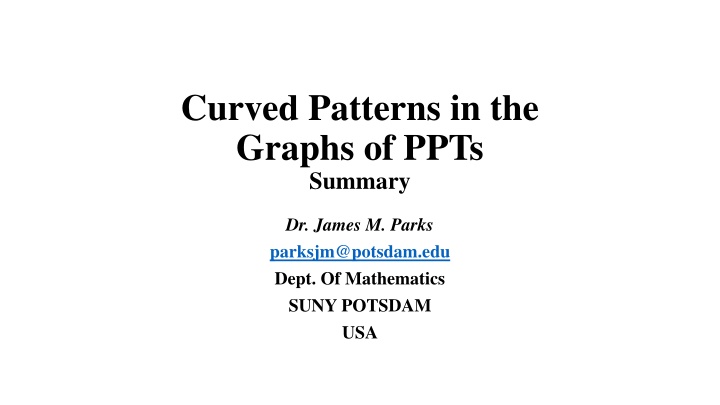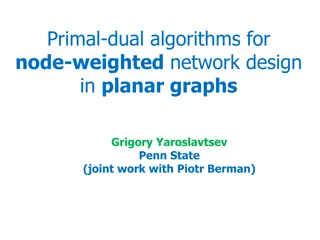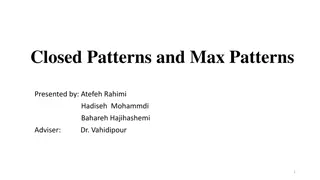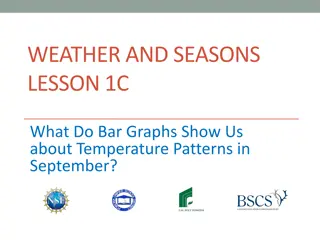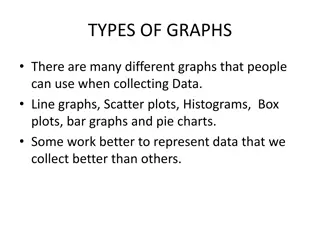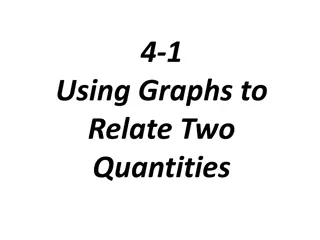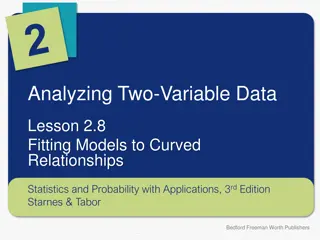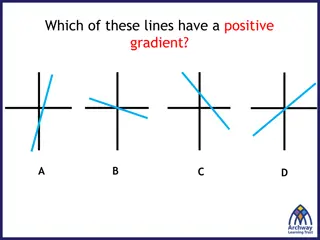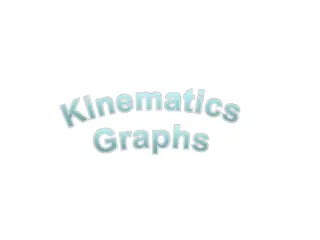Curved Patterns in Graphs of PPTs Summary
Pythagorean Triples (PTs) highlight sets of positive integers satisfying a^2 + b^2 = c^2. Dr. James M. Parks explores PTs, particularly Primitive Pythagorean Triples (PPTs), revealing interesting patterns and graph visualization techniques. The analysis delves into the Main Graph and its connection with odd integers, showcasing parabolic curves around the axes. The study unveils a structured correspondence between odd positive integers and specific PT forms, offering insights into the geometric representations and relationships within PTs.
Download Presentation

Please find below an Image/Link to download the presentation.
The content on the website is provided AS IS for your information and personal use only. It may not be sold, licensed, or shared on other websites without obtaining consent from the author.If you encounter any issues during the download, it is possible that the publisher has removed the file from their server.
You are allowed to download the files provided on this website for personal or commercial use, subject to the condition that they are used lawfully. All files are the property of their respective owners.
The content on the website is provided AS IS for your information and personal use only. It may not be sold, licensed, or shared on other websites without obtaining consent from the author.
E N D
Presentation Transcript
Curved Patterns in the Graphs of PPTs Summary Dr. James M. Parks parksjm@potsdam.edu Dept. Of Mathematics SUNY POTSDAM USA
1. Introduction and Basic Facts A Pythagorean Triple (PT for short) is a set of 3 positive integers (a,b,c), such that a^2+b^2 = c^2. For example: (3,4,5), (6,8,10). If the integers a, b, c are relatively prime (GDC{a,b,c} = 1), then call the triple (a,b,c) a Primitive Pythagorean Triple (PPT for short). Given a PT (a,b,c), a<b<c, graph it by choosing the ordered pair (a,b) and graph this in the 1st quadrant of the xy-plane Fig.1.1, (all graphs except Fig.1.2 are on Sketchpad). The right triangle ABC with sides a,b,c is congruent to the triangle formed by the origin O, the point (a,0), and the point (a,b). Another copy of ABC is provided by the graph of the point (b,a).
PPTGraph (a,b,c)<------->(a,b)
Graph all PPTs with 0 < a < b <10,000, and their reflected points (Mathematica), Fig.1.2. Call this the Main Graph. The points (a,b) are red, and the points (b,a) are black. Figure 1.2 Graph of all PPTs with 0<a<b<10,000
2. Analysis of the Main Graph Consider the following set of the first 18 PPTs by term a: 3, 4, 5 5, 12, 13 7, 24, 25 8, 15, 17 9, 40, 41 11, 60, 61 12, 35, 37 13, 84, 8515, 112, 113 16, 63, 65 17, 144, 145 19, 180, 181 20, 21, 29 20, 99,101 21, 220, 221 23, 264, 265 24, 143, 145 25, 312, 313 Those 12 PPTs in boldall have terms a which are odd numbers, and they have the form (a, b, b+1), where c = b+1. These triples are obviously relatively prime (consecutive numbers do not have any common divisors), and they satisfy the equivalent equation: b = (a^2 -1)/2.
This means that a^2 (and thus a) must be an odd integer, so b is an even integer, and conversely. Thus, these PPTs all have the form: (a, (a^2-1)/2, (a^2+1)/2), for a an odd positive integer. This determines a 1-1 correspondence between odd positive integers a and those PPTs which have the form (a, b, b+1). The odd integers 3, 5, 7, 9,..., 25, determine the points corresponding to the PPTs given in bold in the list above. A graph of these points and their reflected points in the xy-plane for the range 0 < a,b < 120 is given in Fig. 2.1.
The points are on parabolic curves about the positive x and y axes. The red points (a,b) have the form (a, (a^2 -1)/2), so they satisfy the parabola equation: y = (x^2 -1)/2. The black reflected points (b,a) have the form ((a^2 -1)/2, a), so they satisfy the (reflected) parabola equation: x = (y^2 -1)/2, Fig. 2.2. In general we have PPTs of the form (a,b,b+d), for d a positive integer in the sequence: 1, 2, 8, 9, 18, 25, 32, 49, 50, 72, 81, 98, , (OEIS sequence A096033). These PPTs are on the graphs of the parabolic equations: y = (x^2 d^2)/2d, and x = (y^2 d^2)/2d. The graph of some of the representative points and parabolic curves for the first few d values is shown in Fig. 3.1.
Figure 3.1 Representative Points and Parabolic Curves for Beginning d Values
